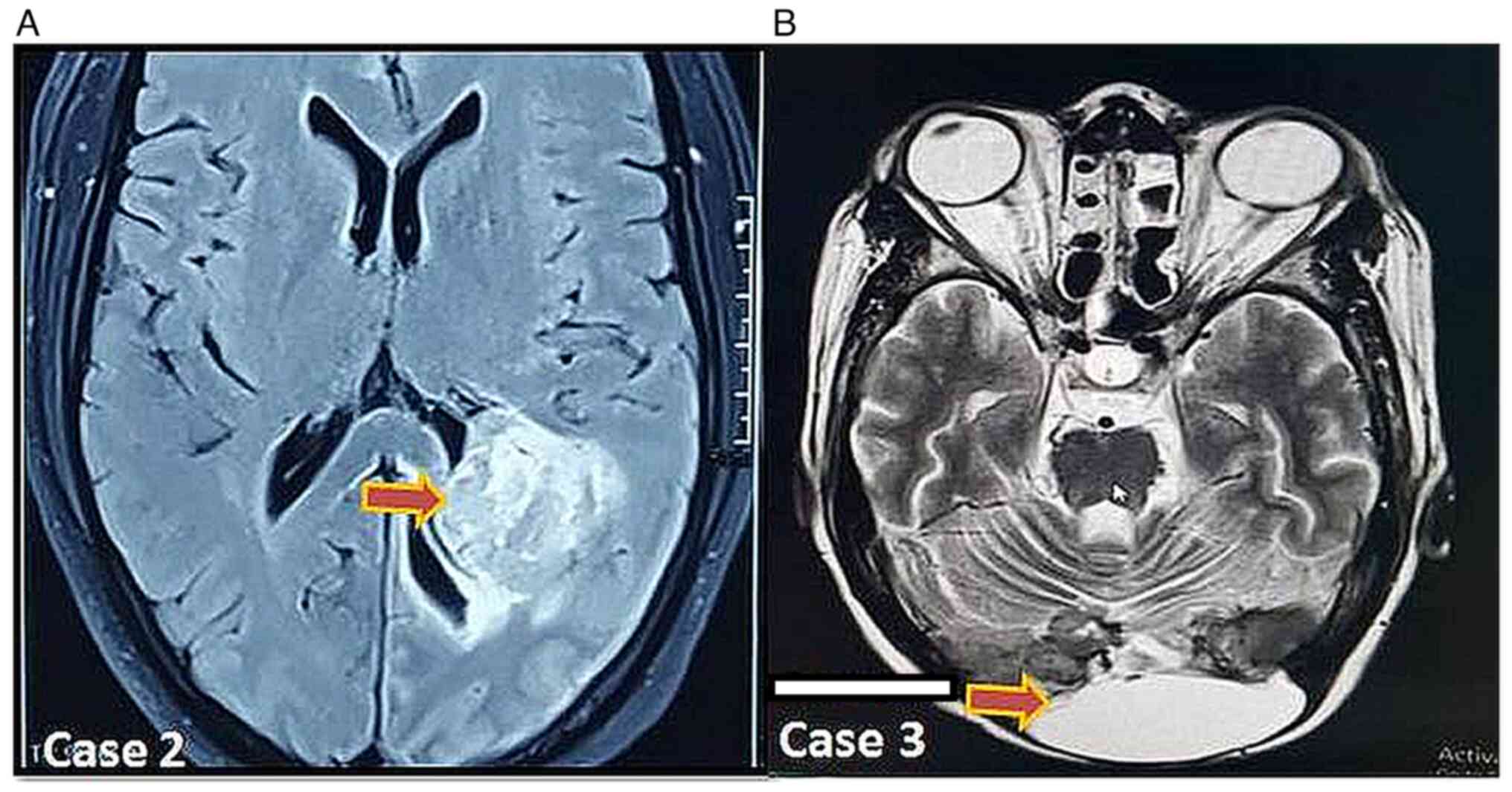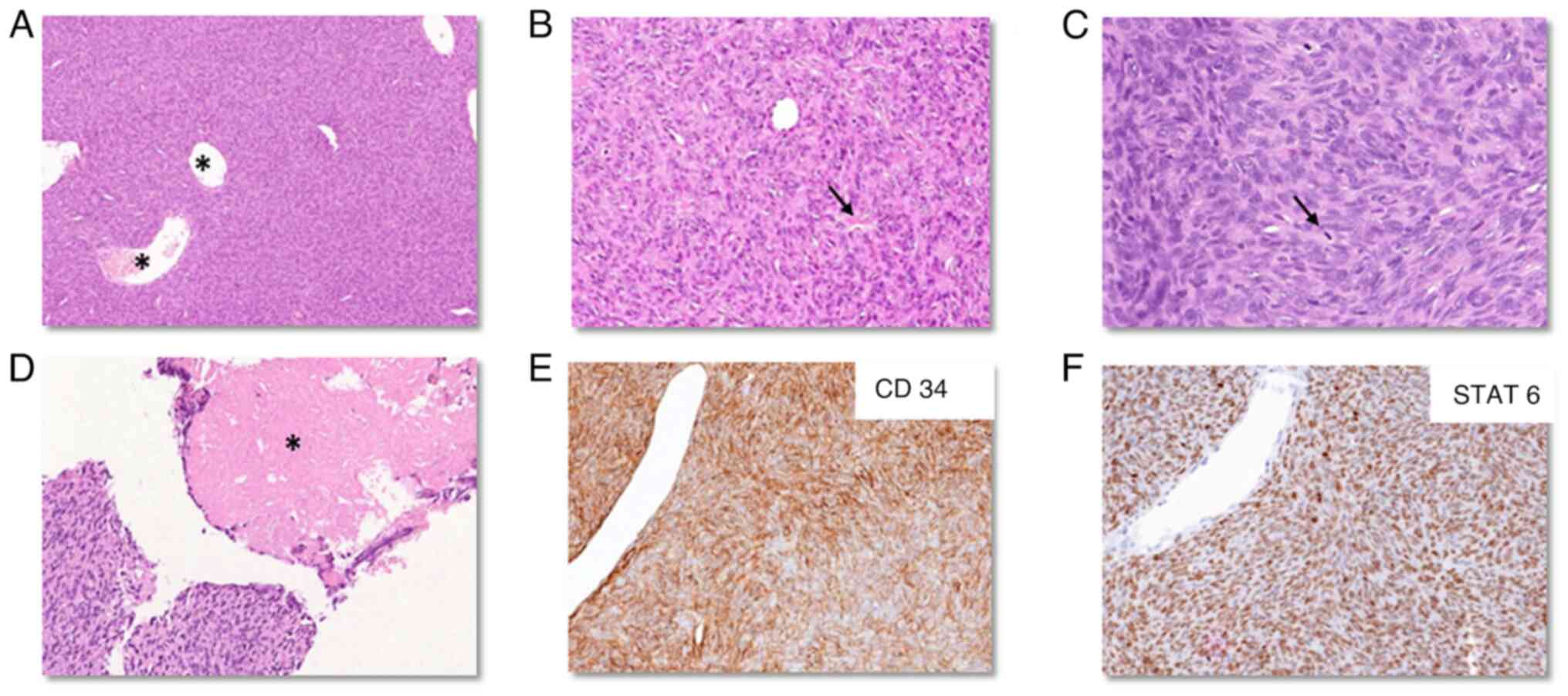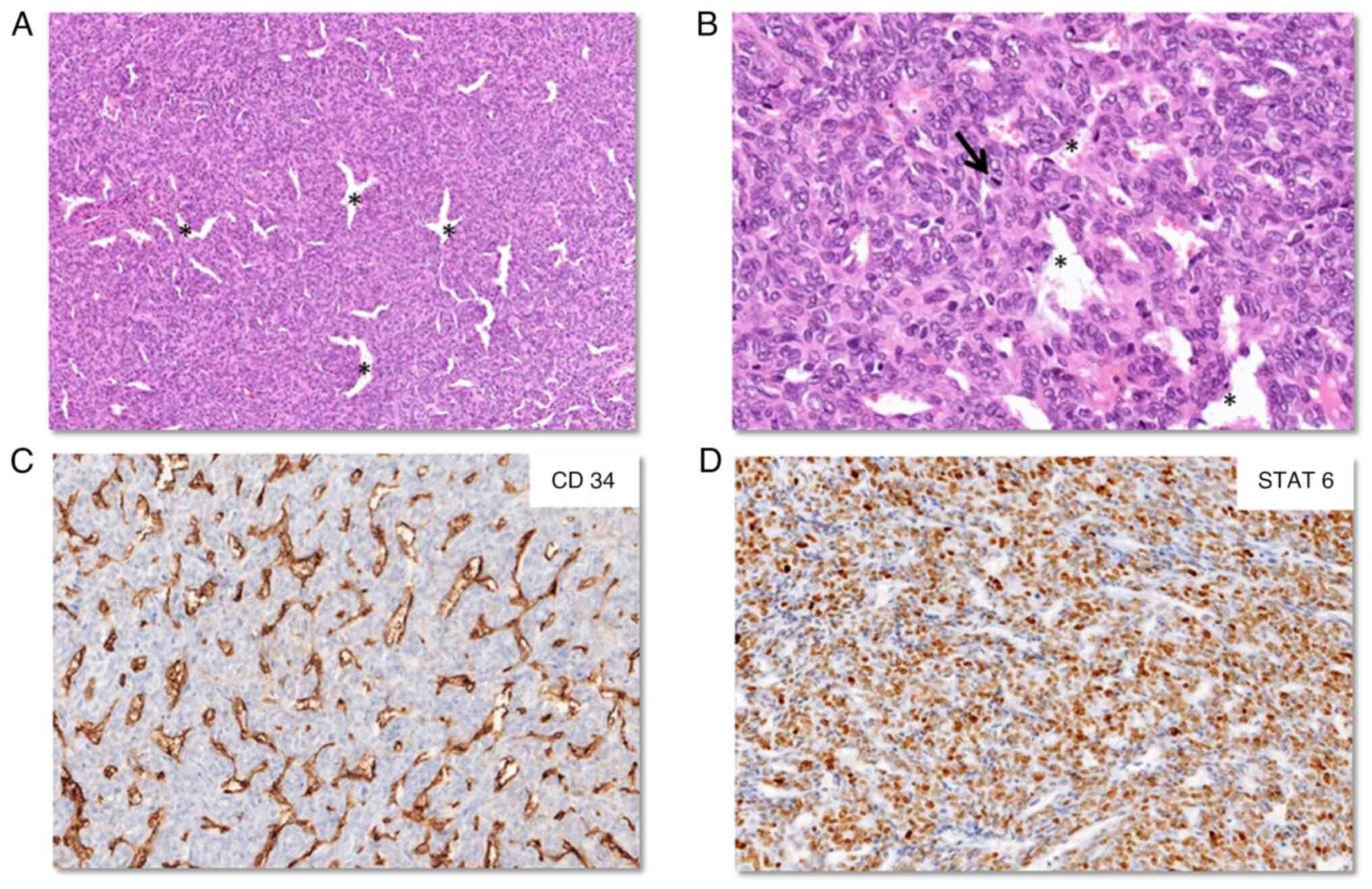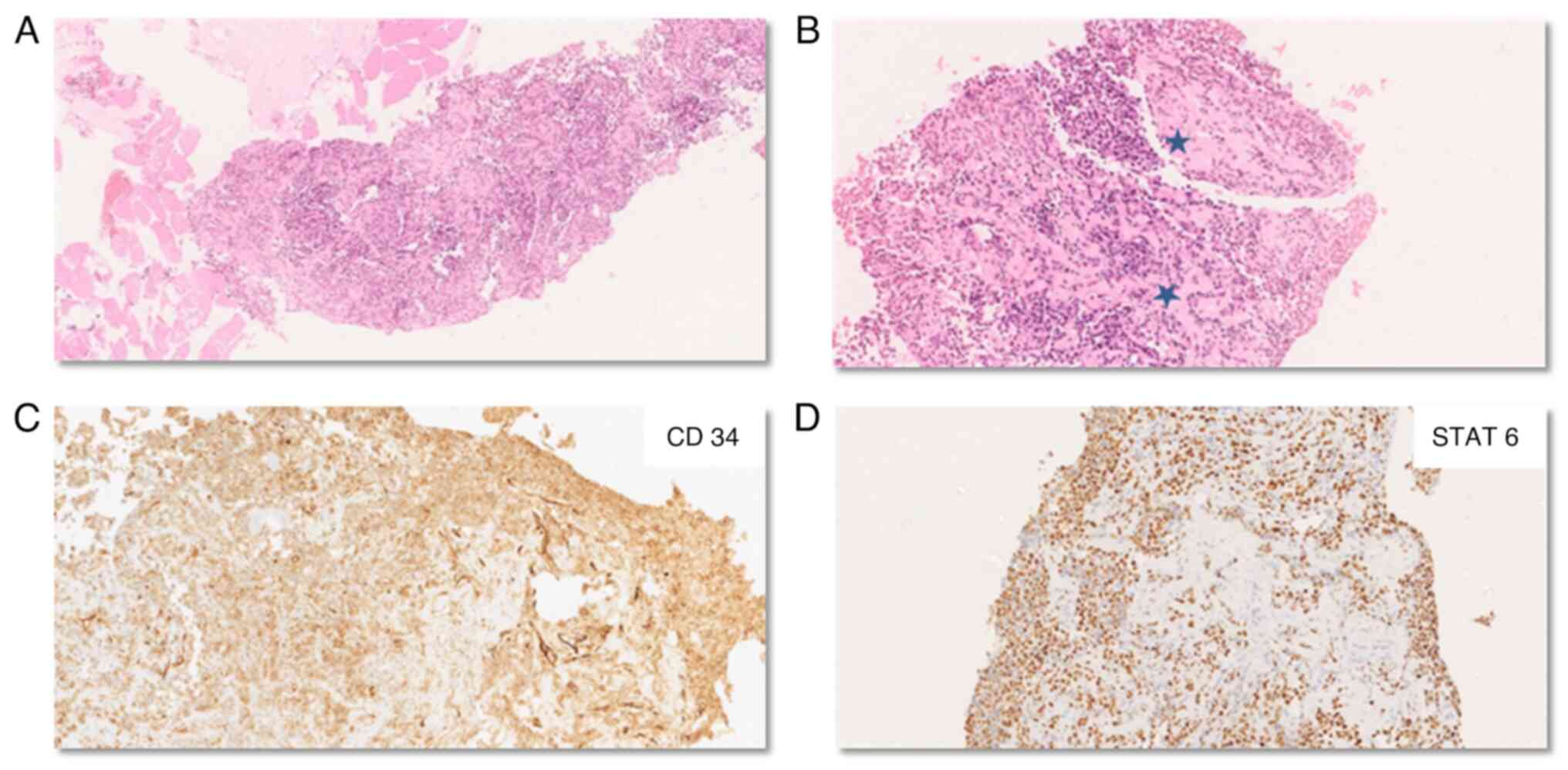Solitary fibrous tumor of the brain: A report of 3 cases
- Authors:
- Published online on: August 9, 2024 https://doi.org/10.3892/ol.2024.14621
- Article Number: 488
-
Copyright: © Chadha et al. This is an open access article distributed under the terms of Creative Commons Attribution License.
Abstract
Introduction
Solitary fibrous tumors (SFTs) are mesenchymal neoplasms of fibroblastic origin that may occur at any site of the body (1). SFTs typically occur in adults and were first described in 1931 in the mediastinum and pleura (2). Superficial and deep soft tissues, viscera or bone, including extremities, abdominal or retroperitoneal cavity, of the head, neck and trunk may be involved (3). SFTs rarely occur in the central nervous system (CNS), accounting for <1% of all primary CNS tumors (4). In the CNS SFTs occur as intracranial extra-axial dura-based tumors, commonly situated in the skull base, falcine or parasagittal locations (5). The clinical presentation is due to the mass effect or raised intracranial pressure of the tumors and a preoperative false diagnosis of meningioma is frequent. Histopathology with immunohistochemistry (IHC) for STAT6 forms the mainstay of diagnosis. A three-tiered grading system based on cellularity, mitotic activity and necrosis is practiced for these tumors according to World Health Organization (WHO) guidelines (5th edition) (6). Gross total resection with adjuvant radiotherapy is the preferred treatment strategy while additional chemotherapy may be administered for metastatic disease (4). In the present study, 3 cases of intracranial SFTs over a period of 5 years are reported, 1 of which had an intraventricular location, and another showed evidence of local recurrence and distant metastasis.
Case report
Methods
All cases reported as SFT/hemangiopericytoma of the brain between January, 2019 and December, 2023 were collected and the clinical details were retrieved from the hospital medical records at Rajiv Gandhi Cancer Institute and Research Centre (RGCIRC), Delhi, India.
Histopathological examination was performed using 3-µm thick sections cut from formalin fixed (10% neutral buffered formalin) paraffin embedded blocks (paraffin wax used at a melting point of 56–58°C for 2-4 h). Fixation was conducted at room temperature for 6-48 h followed by further fixation at 45–50°C during tissue processing as per the in-house protocol. Hematoxylin and eosin staining was performed at room temperature for ~50 min in a Leica autostainer XL (ST5010; Leica Microsystems GmbH) according to manufacturer's protocol. Immunostaining for STAT6 (rabbit monoclonal antibody clone EP325; 1:100; cat. no. BSB-3809-05; Bio SB Inc.), CD34 (rabbit monoclonal antibody clone EP88; 1:100; cat. no. 134R-16-RUO; Cell Marque; Merck KGaA) and Ki67 (mouse monoclonal antibody clone MIB-1; 1:100; cat. no. Z2305ML; Zeta Corporation) at 37°C for 44 min was conducted using a Ventana BenchMark XT 750-700 Automated IHC/ISH autostainer (Roche Diagnostics, Ltd.) was performed as per the manufacturer's protocol, using heat-induced antigen retrieval (100°C, 4 min) and endogenous peroxidase blocking by 0.04% hydrogen peroxide. The signal amplification and signal generation were accomplished using the Ventana polymer-based OptiView system (Roche Diagnostics, Ltd.), which includes the secondary HRP antibody multimer (cat. no. 253-4580) and is incubated at room temperature for 12 min. Finally, the samples were stained with DAB. The hematoxylin and eosin-stained and IHC slides were reviewed by two pathologists under a light microscope. Ki67 assessment was conducted manually.
A total of 3 cases were identified over the study period with a mean age at diagnosis of 45.6 years (age range, 30-60 years). Of these patients, 2 were male and 1 was female. The clinical presentation included vision disturbances and headache. All 3 cases were preoperatively diagnosed as meningioma on imaging (Fig. 1). The patients underwent decompression surgery and were referred to RGCIRC for further treatment, evaluation and second opinion. The slides and blocks were brought to RGCIRC for review. The clinicopathological features of the patients are summarized in Table I.
Case 1
A 60-year-old male was referred to RGCIRC in January, 2022 with complaints of blurred vision and bifrontal headache for 1 year and amnesia for 3 months. Contrast enhanced magnetic resonance imaging (CEMRI) scan findings showed an extra axial mass in the right temporo-occipital region measuring ~6×5×4-cm. A clinical diagnosis of meningioma was considered. The patient underwent a decompression surgery followed by radiotherapy. On histopathology, the tumor was composed of spindled to ovoid monomorphic appearing cells arranged in an ill-formed fascicles and vague storiform architecture with the presence of a dilated thin walled (hemangiopericytomatous) vasculature and focal keloidal collagen and amianthoid fibers (Fig. 2A and B). The tumor cells showed mild to moderate nuclear pleomorphism. Mitosis was 15/10 high power fields (HPF) with focal necrosis (Fig. 2C and D). By IHC, tumor cells were diffusely positive for CD34 (Fig. 2E) and STAT6 (Fig. 2F), but negative for CK, glial fibrillary acidic protein (GFAP) and S100. The Ki-67 labelling index was 15–20%. A final diagnosis of SFT CNS WHO grade 3 was considered (6). The patient was treated with radiotherapy at 60 Gy in 30 fractions. At present, the patient remains disease-free after a follow-up period of 2 years and 9 months.
Case 2
A 35-year-old diabetic male patient presented with severe headache for 3 days associated with pain in both the eyes at Global Rainbow Healthcare Hospital (Agra, India) in January, 2021. Non-contrast computerized tomography of the head showed an ill-defined intraventricular mass measuring 4.6×3.2-cm involving the body and trigone of the left lateral ventricle, with an associated ventricular bleed extending into the adjacent occipital lobe. The CEMRI (Fig. 1) showed similar findings of an intraventricular space occupying lesion (SOL) involving the left occipital horn with intense enhancement and hypointense signal on T2W images suggestive of an intraventricular meningioma with subacute hemorrhage in the left occipital lobe. The patient was also preoperatively diagnosed with meningioma. Following surgery at Global Rainbow Healthcare Hospital the patient was referred to RGCIRC in January, 2021 for a second opinion and further treatment. The patient received adjuvant radiotherapy of 60 Gy in 30 fractions at RGCIRC.
Sections from the intracranial specimen showed a cellular tumor composed of spindle-shaped cells arranged in a ‘patternless’ architecture with numerous interspersed dilated vessels. The cells showed indistinct cell borders with ovoid nuclei having inconspicuous nucleoli. The mitotic rate was 9/10 HPF and no necrosis was observed (Fig. 3A and B). On IHC, the tumor cells diffusely expressed STAT6 (Fig. 3D), but were negative for CD34 (Fig. 3C), CK, epithelial membrane antigen (EMA), GFAP and synaptophysin. The MIB1 labelling index was 8–10%. The integrated diagnosis given was SFT CNS WHO grade 2. The patient remains disease free after 2 years of follow-up.
Case 3
A 42-year-old female presented with bilateral loss of vision, memory disturbance and bilateral paresis for 6 months, causing the patient to be bed ridden and was admitted to BHU (Varanasi, India) in February, 2011. Surgery was performed on the patient for a dura-based intracranial SOL, which was diagnosed as an anaplastic meningioma CNS WHO grade 3 on histopathology. The patient subsequently received 60 Gy of radiotherapy in 30 fractions. Surgery was again performed in 2016 and 2019 when the patient developed recurrences while receiving radiotherapy. The patient was admitted to RGCIRC in 2019, and following CEMRI, a post-op status of a dura-based lesion in the occipital and posterior fossa region with multiple bilateral cerebral nodules was revealed. The patient underwent a PET/CT, which detected bilateral lung metastasis in the form of sub pleural nodules, cervical supraclavicular lymphadenopathy and a lytic lesion in the sacrum with a soft tissue component. The slides and paraffin-embedded blocks from the dura-based lesion were also reviewed at RGCIRC along with a tru-cut biopsy of the lung nodule. A biopsy from the supraclavicular lymph node showed granulomatous lymphadenitis with no evidence of malignancy. The patient received pazopanib (tyrosine kinase inhibitor) for 9 months at an initial dose of 400 mg twice a day (BD) and then de-escalated to 200 mg BD. This treatment was stopped once the patient developed a recurrence detected in 2021, when the patient complained of headaches associated with vomiting. On evaluation, CEMRI of the brain revealed a post-op status with a progressive enhancing dura-based lesion in the occipital and posterior fossa region with extensions, leptomeningeal enhancement, subgaleal collection at the craniotomy site and persistent multiple bilateral cerebral enhancing nodules. A re-exploration and decompression surgery was performed followed by supportive care. The patient developed recurrent seizures and meningitis, for which the patient was treated with intravenous antibiotics [caspofungin 50 mg once daily, fosfomycin 4 g trice daily (TDS) and meropenem 2 g BD], antiepileptics (levetiracetam 1.5 g BD, sodium valproate 500 mg TDS and lacosamide 200 mg BD) and anti-inflammatory drugs (paracetamol 1 g, as required) along with multivitamin syrup, calcium gluconate and pantoprazole 40 mg iv BD. However, the patient left the hospital against medical advice in August, 2021.
The histopathological examination of the primary site and recurrent tumor revealed a cellular spindle cell tumor arranged in solid sheets and a haphazard pattern with limited intervening stroma. The tumor cells were spindle to oval-shaped with ovoid nuclei containing vesicular chromatin and moderate nuclear pleomorphism. A staghorn vasculature was observed interspersed amidst the tumor (Fig. 4A and B). Foci of hemorrhage and necrosis were also noted. The mitosis was brisk (>20/10 HPF). On IHC, tumor cells were observed to express STAT6, which was strong and diffuse, while CD34 showed heterogenous positivity. The tumor cells were negative for GFAP, S100 and smooth muscle actin. An integrated diagnosis of SFT CNS WHO grade 3 was considered (Fig. 4C and D). Biopsy from the subpleural nodule confirmed metastasis with similar histopathology and immunohistochemical findings. The patient died in December, 2021.
Discussion
SFTs of the CNS are rare tumors typically occurring as dural-based supratentorial tumors or uncommonly in the spinal location (6). The precise cell of origin for a CNS SFT remains uncertain and is considered to be of fibroblastic nature, possibly arising from thick collagen bands (7). Due to the dural-based nature and peripheral contrast enhancement commonly known as the ‘dural tail’, CNS SFTs are commonly misdiagnosed as meningiomas radiologically (8). The genetic hallmark of all SFTs is a paracentric inversion involving the long arm of chromosome 12, leading to a fusion of the NGFI-A-binding protein 2 and STAT6 genes that is easily demonstrable as nuclear expression of STAT6 on IHC (9). SFTs typically occur in older adults between the fifth and seventh decades of life, with clinical symptoms related to increased intracranial pressure or the mass effect caused by these tumors. Out of the 3 cases reported in the present study, Case 1 was a 60-year-old male while Cases 2 and 3 were younger patients of 31and 40 years, respectively, who were provisionally diagnosed with meningioma based on the imaging findings. Case 2 presented as an intraventricular mass, which is a very rare site for SFTs. An intraventricular location leads to differential diagnoses encompassing intraventricular meningiomas, choroid plexus tumors, ependymomas, gliomas or even metastasis. To date and to the best of our knowledge, only 11 cases of intraventricular SFTs have been reported in the literature (10–19).
Histopathological examination is the gold standard for diagnosis of SFT. SFT is composed of uniform-appearing spindle-shaped cells disposed in a ‘patternless’ or haphazard arrangement with a typical thin-walled dilated branching ‘hemangiopericytomatous’ vasculature. The terms ‘solitary fibrous tumor’ and ‘hemangiopericytoma’, which were historically considered as two ends of a spectrum, were combined together due to the common genetic signature. However, the latest WHO blue book series has removed the term, hemangiopericytoma, altogether. The morphology can vary from a hypocellular to a markedly cellular phenotype. There can be presence of keloidal-type collagen and amianthoid fibers focally (6). Nuclear pseudoinclusions and calcifications observed in meningiomas are typically not observed in SFTs. An associated adipocytic component or dedifferentiation may be rarely observed both at the time of primary diagnosis or at the time of recurrence (20). Mitosis (≥5/10 HPF in grade 2 and 3 tumors) and necrosis (seen only in grade 3 tumors) form the basis of stratifying these tumors into a three-tiered grading system (21). All 3 cases reported in the present study showed a similar morphology: A cellular spindle cell tumor with a hemangiopericytomatous vasculature interspersed throughout with variable mitosis and necrosis. Cases 1 and 3 were classified as CNS WHO grade 3 SFTs, while Case 2 was considered a CNS WHO grade 2 SFT.
On IHC, SFTs express CD99, CD34 and bcl2, while expression of STAT6 is considered the immunohistochemical hallmark acting as a surrogate for the associated gene fusion. Aldehyde dehydrogenase 1 family member A1 is a newer marker with a notable sensitivity and specificity (6). An IHC panel is generally employed, depending on the morphology and location of the tumor, to rule out the differential diagnoses. A CNS SFT needs to be differentiated from its close mimics such as meningioma (fibrous subtype; characterized by positivity for EMA and somatostatin receptor 2), schwannoma (S100+), sarcomas (such as malignant peripheral nerve sheath tumors), monophasic synovial sarcoma (EMA+, CK+ and TLE1+) and mesenchymal chondrosarcoma (SOX9+, NKX2.2+ and NKX3.1+) along with gliomas (GFAP+) or even metastatic carcinomas (pancytokeratin positive). In the present study, immunonegativity for EMA and GFAP ruled out meningioma and glioma, respectively, while pancytokeratin and S100 negativity was useful in negating metastasis and nerve sheath tumors, respectively. CK and EMA negativity also ruled out a synovial sarcoma. Strong and diffuse positivity for the highly specific marker, STAT6, which was observed in all the 3 cases further assisted in the unequivocal diagnosis of an SFT. In addition, CD34 showed a variable expression, as has been described by other researchers (22).
Meningeal SFTs show a high predilection for local recurrence irrespective of the grade (23). This warrants a long term follow-up and reiterates the importance of distinguishing meningeal SFTs from their closest differential, meningioma. The risk model applied to meningeal SFTs differs from that applied to SFTs of other locations as patient age and tumor size have not been validated as adverse prognostic markers in the CNS. Gross total resection is the treatment of choice followed by adjuvant radiotherapy, which imparts a survival benefit in higher grade tumors (grades 2 and 3) (24). Distant metastasis was seen in only 3% of intracranial SFTs in a large study by Lu et al (25). The 3 cases reported in the present series were treated by surgery followed by radiotherapy. Case 1 remains disease free after a follow-up period of 2 years and 9 months, Case 2 remains disease free after 2 years and Case 3 suffered multiple recurrences and metastasis to the lung and sacrum for which the patient was administered chemotherapy. The Case 3 patient died 10 years after initial presentation. Studies on the role of chemotherapy in intracranial SFTs are scarce; however, it may be used in metastatic cases (26).
In conclusion, intracranial SFTs are rare tumors. The key to recognizing these tumors lies in the knowledge of their existence with a high index of suspicion. Histomorphology and IHC, including the surrogate marker STAT6, are imperative for a correct and timely diagnosis and to differentiate SFTs from their close mimics. A three-tiered grading system should be applied to risk stratify these tumors, which show a high propensity of recurrence. Metastasis is rare, yet a known complication of this multifaceted tumor.
Acknowledgements
Not applicable.
Funding
Funding: No funding was received.
Availability of data and materials
The data generated in the present study may be requested from the corresponding author.
Authors' contributions
GD, PC, AS, SP and AM performed the histological examination. ICP performed the surgical procedures and was responsible for taking follow-up of the patients. PC, AS and GD were major contributors in drafting the manuscript. GD and PC were also responsible for the critical revision of the manuscript. GD and PC confirm the authenticity of all the raw data. All authors read and approved the final version of the manuscript.
Ethics approval and consent to participate
This study has been reviewed and approved by the Institutional Review Board of Rajiv Gandhi Cancer Institute and Research Centre (New Delhi, India; IRB no. IRB-BHR 40/2024).
Patient consent for publication
Written informed patient/next of kin consent was obtained for publication.
Competing interests
The authors declare that they have no competing interests.
References
|
International Agency for Research on Cancer, . WHO Classification of Tumours Editorial Board. Soft tissue and bone tumours (Internet). WHO classification of tumours series; 5th edition. volume 3. Lyon, France: https://tumourclassification.iarc.who.int/chapters/33March 8–2024 | |
|
Klemperer P and Rabin CB: Primary neoplasms of the pleura. A report of five cases. Arch Pathol. 11:385–412. 1931. | |
|
Gholami S, Cassidy MR, Kirane A, Kuk D, Zanchelli B, Antonescu CR, Singer S and Brennan M: Size and location are the most important risk factors for malignant behavior in resected solitary fibrous tumors. Ann Surg Oncol. 24:3865–3871. 2017. View Article : Google Scholar : PubMed/NCBI | |
|
Damodaran O, Robbins P, Knuckey N, Bynevelt M, Wong G and Lee G: Primary intracranial haemangiopericytoma: Comparison of survival outcomes and metastatic potential in WHO grade II and III variants. J Clin Neurosci. 21:1310–1314. 2014. View Article : Google Scholar : PubMed/NCBI | |
|
Mena H, Ribas JL, Pezeshkpour GH, Cowan DN and Parisi JE: Hemangiopericytoma of the central nervous system: A review of 94 cases. Hum Pathol. 22:84–91. 1991. View Article : Google Scholar : PubMed/NCBI | |
|
Ng Ho-Keung, Lazar AJ and Giannini C: Mesenchymal, non meningothelial tumors involving the CNS. Haematolymphoid Tumours WHO Classification of Tumours. 5th edition. IARC Press; Lyon: pp. 301–305. 2021 | |
|
Lin Q, Zhu J and Zhang X: Solitary fibrous tumor of the central nervous system invading and penetrating the skull: A case report. Oncol Lett. 25:812023. View Article : Google Scholar : PubMed/NCBI | |
|
Chen T, Jiang B, Zheng Y, She D, Zhang H, Xing Z and Cao D: Differentiating intracranial solitary fibrous tumor/hemangiopericytoma from meningioma using diffusion-weighted imaging and susceptibility-weighted imaging. Neuroradiology. 62:175–184. 2020. View Article : Google Scholar : PubMed/NCBI | |
|
Schweizer L, Koelsche C, Sahm F, Piro RM, Capper D, Reuss DE, Pusch S, Habel A, Meyer J, Göck T, et al: Meningeal hemangiopericytoma and solitary fibrous tumors carry the NAB2-STAT6 fusion and can be diagnosed by nuclear expression of STAT6 protein. Acta Neuropathol. 125:651–658. 2013. View Article : Google Scholar : PubMed/NCBI | |
|
Nguyen A, Shan Y, Lyon K and Vance AZ: Lateral ventricle solitary fibrous tumor: A case report and review of the literature. Cureus. 14:e231062022.PubMed/NCBI | |
|
Li X, Tan L, Ouyang X, Jiang J, Huang S, Huang Y, Li S and Chen D: Magnetic resonance features of meningeal solitary fibrous tumors. Oncol Lett. 15:8825–8832. 2018.PubMed/NCBI | |
|
Bell SL, Suttner NJ and Stewart W: An unusual intraventricular tumor. Neuropathology. 32:311–313. 2012. View Article : Google Scholar : PubMed/NCBI | |
|
Vassal F, Manet R, Forest F, Camdessanche JP, Péoc'h M and Nuti C: Solitary fibrous tumors of the central nervous system: Report of five cases with unusual clinicopathological and outcome patterns. Acta Neurochir (Wien). 153:377–384. 2011. View Article : Google Scholar : PubMed/NCBI | |
|
Mekni A, Kourda J, Hammouda KB, Tangour M, Kchir N, Zitouna M and Haouet S: Solitary fibrous tumour of the central nervous system: Pathological study of eight cases and review of the literature. Pathology. 41:649–654. 2009. View Article : Google Scholar : PubMed/NCBI | |
|
Boada M, Gómez E, Puig J and Pedraza S: Intraventricular fibrous tumor: A case report. Radiologia. 51:512–515. 2009.(In Spanish). View Article : Google Scholar : PubMed/NCBI | |
|
Kinfe TM, Tschan CA, Stan AC and Krauss JK: Solitary fibrous tumor of the foramen of Monro. Clin Neurol Neurosurg. 110:404–407. 2008. View Article : Google Scholar : PubMed/NCBI | |
|
Clarençon F, Bonneville F, Chiras J, Kujas M and Cornu P: Cystic intraventricular solitary fibrous tumor. AJNR Am J Neuroradiol. 28:1205–1206. 2007. View Article : Google Scholar : PubMed/NCBI | |
|
Surendrababu NRS, Chacko G, Daniel RT and Chacko AG: Solitary fibrous tumor of the lateral ventricle: CT appearances and pathologic correlation with follow-up. AJNR Am J Neuroradiol. 27:2135–1236. 2006.PubMed/NCBI | |
|
Tihan T, Viglione M, Rosenblum MK, Olivi A and Burger PC: Solitary fibrous tumors in the central nervous system. A clinicopathologic review of 18 cases and comparison to meningeal hemangiopericytomas. Arch Pathol Lab Med. 127:432–439. 2003. View Article : Google Scholar : PubMed/NCBI | |
|
Tariq MU, Din NU, Abdul-Ghafar J and Park YK: The many faces of solitary fibrous tumor; diversity of histological features, differential diagnosis and role of molecular studies and surrogate markers in avoiding misdiagnosis and predicting the behavior. Diagn Pathol. 16:322021. View Article : Google Scholar : PubMed/NCBI | |
|
Fritchie K, Jensch K, Moskalev EA, Caron A, Jenkins S, Link M, Brown PD, Rodriguez FJ, Guajardo A, Brat D, et al: The impact of histopathology and NAB2-STAT6 fusion subtype in classification and grading of meningeal solitary fibrous tumor/hemangiopericytoma. Acta Neuropathol. 137:307–319. 2019. View Article : Google Scholar : PubMed/NCBI | |
|
Perry A, Scheithauer BW and Nascimento AG: The immunophenotypic spectrum of meningeal hemangiopericytoma: A comparison with fibrous meningioma and solitary fibrous tumor of meninges. Am J Surg Pathol. 21:1354–1360. 1997. View Article : Google Scholar : PubMed/NCBI | |
|
Macagno N, Vogels R, Appay R, Colin C, Mokhtari K; French CNS SFT/HPC Consortium; Dutch CNS SFT/HPC Consortium, ; Küsters B, Wesseling P, Figarella-Branger D, et al: Grading of meningeal solitary fibrous tumors/hemangiopericytomas: Analysis of the prognostic value of the marseille grading system in a cohort of 132 patients. Brain Pathol. 29:18–27. 2019. View Article : Google Scholar : PubMed/NCBI | |
|
Kinslow CJ, Rae AI, Kumar P, McKhann GM, Sisti MB, Bruce JN, Yu JB, Cheng SK and Wang TJC: Risk stratification for management of solitary fibrous tumor/hemangioperi-cytoma of the central nervous system. Cancers (Basel). 15:8762023. View Article : Google Scholar : PubMed/NCBI | |
|
Lu T, Xu H, Dong X, Jin Z and Wang Y: Epidemiology and survival of patients with central nervous system solitary fibrous tumors: A population-based analysis. Front Oncol. 12:9776292023. View Article : Google Scholar : PubMed/NCBI | |
|
Son S, Lee SG, Jeong DH and Yoo CJ: Malignant solitary fibrous tumor of tandem lesions in the skull and spine. J Korean Neurosurg Soc. 54:246–249. 2013. View Article : Google Scholar : PubMed/NCBI |













